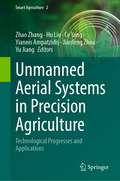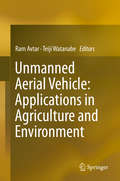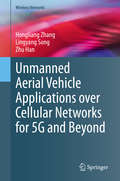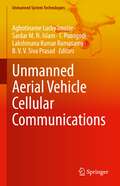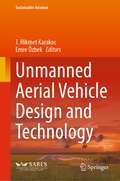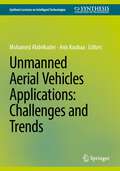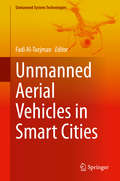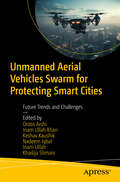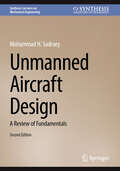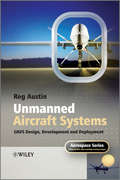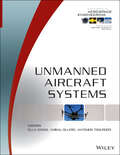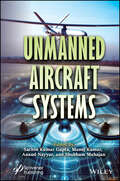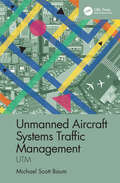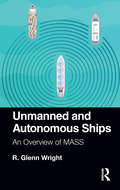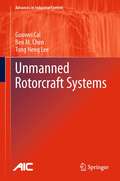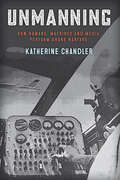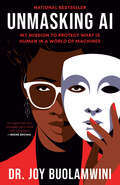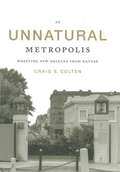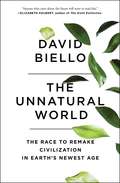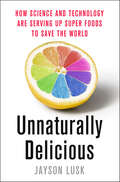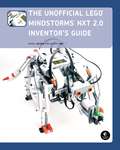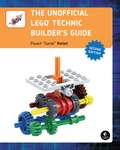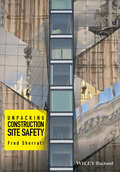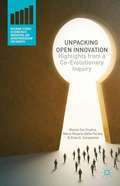- Table View
- List View
Unmanned Aerial Systems in Precision Agriculture: Technological Progresses and Applications (Smart Agriculture #2)
by Zhao Zhang Hu Liu Ce Yang Yiannis Ampatzidis Jianfeng Zhou Yu JiangThis book, consisting of 8 chapters, describes the state-of-the-art technological progress and applications of unmanned aerial vehicles (UAVs) in precision agriculture. It focuses on the UAV application in agriculture, such as crop disease detection, mid-season yield estimation, crop nutrient status, and high-throughput phenotyping. Different from individual papers focusing on a specific application, this book provides a holistic view for readers with a wide range of subjects. In addition to researchers in the areas of plant science, plant pathology, breeding, engineering, it is also intended for undergraduates and graduates who are interested in imaging processing, artificial intelligence in agriculture, precision agriculture, agricultural automation, and robotics.
Unmanned Aerial Vehicle: Applications in Agriculture and Environment
by Ram Avtar Teiji WatanabeThis book showcases how new and emerging technologies like Unmanned Aerial Vehicles (UAVs) are trying to provide solutions to unresolved socio-economic and environmental problems. Unmanned vehicles can be classified into five different types according to their operation. These five types are unmanned ground vehicles, unmanned aerial vehicles, unmanned surface vehicles (operating on the surface of the water), unmanned underwater vehicles, and unmanned spacecraft. Unmanned vehicles can be guided remotely or function as autonomous vehicles. The technology has a wide range of uses including agriculture, industry, transport, communication, surveillance and environment applications. UAVs are widely used in precision agriculture; from monitoring the crops to crop damage assessment. This book explains the different methods in which they are used, providing step-by-step image processing and sample data. It also discusses how smart UAVs will provide unique opportunities for manufacturers to utilise new technological trends to overcome the current challenges of UAV applications. The book will be of great interest to researchers engaged in forest carbon measurement, road patrolling, plantation monitoring, crop yield estimation, crop damage assessment, terrain modelling, fertilizer control, and pest control.
Unmanned Aerial Vehicle Applications over Cellular Networks for 5G and Beyond (Wireless Networks)
by Hongliang Zhang Lingyang Song Zhu HanThis book discusses how to plan the time-variant placements of the UAVs served as base station (BS)/relay, which is very challenging due to the complicated 3D propagation environments, as well as many other practical constraints such as power and flying speed. Spectrum sharing with existing cellular networks is also investigated in this book. The emerging unmanned aerial vehicles (UAVs) have been playing an increasing role in the military, public, and civil applications. To seamlessly integrate UAVs into future cellular networks, this book will cover two main scenarios of UAV applications as follows. The first type of applications can be referred to as UAV Assisted Cellular Communications.Second type of application is to exploit UAVs for sensing purposes, such as smart agriculture, security monitoring, and traffic surveillance. Due to the limited computation capability of UAVs, the real-time sensory data needs to be transmitted to the BS for real-time data processing. The cellular networks are necessarily committed to support the data transmission for UAVs, which the authors refer to as Cellular assisted UAV Sensing. To support real-time sensing streaming, the authors design joint sensing and communication protocols, develop novel beamforming and estimation algorithms, and study efficient distributed resource optimization methods.This book targets signal processing engineers, computer and information scientists, applied mathematicians and statisticians, as well as systems engineers to carve out the role that analytical and experimental engineering has to play in UAV research and development. Undergraduate students, industry managers, government research agency workers and general readers interested in the fields of communications and networks will also want to read this book.
Unmanned Aerial Vehicle Cellular Communications (Unmanned System Technologies)
by Agbotiname Lucky Imoize Sardar M. N. Islam T. Poongodi Lakshmana Kumar Ramasamy B. V. V. Siva PrasadThe book discusses how Unmanned Aerial Vehicles (UAVs) can leverage the sub-6 GHz massive MIMO to address cell selection and interference issues in future wireless networks. The book takes a close look at utilizing UAVs to achieving direct and efficient device-to device (D2D) communications in the sky. Also, the key 6G enablers (cell-free architectures, artificial intelligence, reconfigurable intelligent surfaces, THz communications, and non-terrestrial networks) for UAV communication are broached, and the primary technological challenges of each enabler are discussed extensively. Furthermore, the book covers the design of adaptable UAVs to operate in diverse and harsh environmental conditions. Additionally, the existing UAVs’ networking protocols and how these can be greatly enhanced to address the issue of intermittent network changes and channel impairments are discussed. The prospects and societal benefits envisioned in future UAVs are also presented.
Unmanned Aerial Vehicle Design and Technology (Sustainable Aviation)
by T. Hikmet Karakoc Emre ÖzbekUnmanned Aerial Vehicle Design and Technology provides readers with a comprehensive introduction to unmanned aerial systems (UAS) technology basics. The book presents clear, concise guidance on UAS system design, components, control, and operations fundamentals. Additional chapters look at unmanned aerial regulations and ethics and the historical background of UAS technology. This textbook offers a well-rounded look at unmanned flight technology, making it an ideal primer for aviation and aerospace students and anyone interested in learning more about unmanned aerial systems, including engineers, technicians, drone and flight hobbyists, and civil aviation organization officials.
Unmanned Aerial Vehicles Applications: Challenges and Trends (Synthesis Lectures on Intelligent Technologies)
by Mohamed Abdelkader Anis KoubaaThis is a book that covers different aspects of UAV technology, including design and development, applications, security and communication, and legal and regulatory challenges. The book is divided into 13 chapters, grouped into four parts. The first part discusses the design and development of UAVs, including ROS customization, structured designs, and intelligent trajectory tracking. The second part explores diverse applications such as search and rescue, monitoring distributed parameter systems, and leveraging drone technology in accounting. The third part focuses on security and communication challenges, including security concerns, multi-UAV systems, and communications security. The final part delves into the legal and regulatory challenges of integrating UAVs into non-segregated airspace. The book serves as a valuable resource for researchers, practitioners, and students in the field of unmanned aerial vehicles, providing a comprehensive understanding of UAV technology and its applications.
Unmanned Aerial Vehicles in Smart Cities (Unmanned System Technologies)
by Fadi Al-TurjmanThis book addresses the major challenges in realizing unmanned aerial vehicles (UAVs) in IoT-based Smart Cities. The challenges tackled vary from cost and energy efficiency to availability and service quality. The aim of this book is to focus on both the design and implementation aspects of the UAV-based approaches in IoT-enabled smart cities’ applications that are enabled and supported by wireless sensor networks, 5G, and beyond. The contributors mainly focus on data delivery approaches and their performability aspects. This book is meant for readers of varying disciplines who are interested in implementing the smart planet/environments vision via wireless/wired enabling technologies.Involves the most up to date unmanned aerial vehicles (UAV) assessment and evaluation approachesIncludes innovative operational ideas in agriculture, surveillance, rescue, etc.Pertains researchers, scientists, engineers and practitioners in the field of smart cities, IoT, and communicationsFadi Al-Turjman received his Ph.D. from Queen’s University, Canada. He is a full professor and a research center director at Near East University, Nicosia. He is a leading authority in the area of IoT and intelligent systems. His publication history spans over 250 publications in addition to his editorialship in top journals such as the IEEE Communication Surveys and Tutorials, and the Elsevier Sustaibable Cities and Society.
Unmanned Aerial Vehicles Swarm for Protecting Smart Cities: Future Trends and Challenges
by Keshav Kaushik Inam Ullah Khan Inam Ullah Oroos Arshi Nadeem Iqbal Khadija SlimaniExplore the intersection between unmanned aerial vehicles (UAVs) and the evolving landscape of smart cities. With the increasing integration of technology into urban environments, there is a growing need to understand how UAV swarms can contribute to the safety, efficiency, and resilience of these complex urban ecosystems. The book aims to provide a technical understanding of UAV swarms and their applications within the context of smart cities. It begins by laying the groundwork with an introduction to UAV swarms and smart cities, establishing the foundational concepts and motivations behind their integration. As the book progresses, it delves into various aspects of smart cities, exploring concepts, technologies, and challenges inherent in their development and operation. This includes discussions on cloud computing, cybersecurity, machine learning applications, surveillance and monitoring systems, urban planning, and infrastructure management. It also examines the integration of IoT devices with UAV swarms, highlighting the synergies between these emerging technologies and their potential impact on urban environments. The book examines cutting-edge topics such as edge computing, blockchain applications, 5G integration, and augmented reality/virtual reality (AR/VR) visualization techniques in the context of UAV swarm operations. It concludes with reflections on innovations and future directions, offering insights into the evolving landscape of UAV swarm technologies and their implications for the protection and advancement of smart cities. The book serves as a comprehensive guide for researchers, practitioners, and policymakers interested in understanding the technical, social, and economic dimensions of UAV swarm technology within the context of smart city development and management. What You Will Learn Identify practical applications of UAV swarms in surveillance monitoring, urban planning, disaster management, and infrastructure resilience Gain comprehensive understanding of UAV swarms by exploring diverse disciplines Apply insights from emerging technologies like cloud computing, machine learning, blockchain, IoT devices, and so on to UAV swarm technology Who Is This Book For This book appeals to a wide range of readers with different interests and backgrounds, including researchers, policymakers, industry stakeholders, practitioners, experts, and general fans who are curious in the confluence of smart cities with UAV swarm technologies with little to no experience or knowledge of UAV swarms.
Unmanned Aircraft Design: A Review of Fundamentals (Synthesis Lectures on Mechanical Engineering)
by Mohammad H. SadraeyThis book provides fundamental principles, design procedures, and design tools for unmanned aerial vehicles (UAVs) with three sections focusing on vehicle design, autopilot design, and ground system design. The design of manned aircraft and the design of UAVs have some similarities and some differences. They include the design process, constraints (e.g., g-load, pressurization), and UAV main components (autopilot, ground station, communications system, sensors, and payload). A UAV designer must be aware of the latest UAV developments; current technologies; know lessons learned from past failures; and they should appreciate the breadth of UAV design options. The contribution of unmanned aircraft continues to expand every day and over 67 countries are developing and employing UAVs for both military and civil/scientific purposes. A UAV system is much more than a reusable air vehicle or vehicles. UAVs are air vehicles, they fly like airplanes and operate in an airplane environment. They are designed like air vehicles; they have to meet critical air vehicle requirements. A designer needs to know how to integrate complex, multi-disciplinary systems, and to understand the environment, the requirements and the design challenges and this book is an excellent overview of the fundamentals from an engineering perspective. This book is meant to meet the needs of newcomers into the world of UAVs. The materials are intended to provide enough information in each area and illustrate how they all play together to support the design of a complete UAV. Therefore, this book can be used both as a reference for engineers entering the field or as a supplementary text for a UAV design course to provide system-level context for each specialized topic. The second edition is extensively revised. Some of the new terminologies, concepts, and specific unmanned aircraft systems are introduced. The revisions make the book clearer and easier to understand, and will add number of new subjects in areas that have become more prominent in the unmanned aviation world.
Unmanned Aircraft Systems
by Reg AustinUnmanned Aircraft Systems delivers a much needed introduction to UAV System technology, taking an integrated approach that avoids compartmentalising the subject. Arranged in four sections, parts 1-3 examine the way in which various engineering disciplines affect the design, development and deployment of UAS. The fourth section assesses the future challenges and opportunities of UAS.Technological innovation and increasingly diverse applications are two key drivers of the rapid expansion of UAS technology. The global defence budget for UAS procurement is expanding, and in the future the market for civilian UAVs is expected to outmatch that of the military. Agriculture, meteorology, conservation and border control are just a few of the diverse areas in which UAVs are making a significant impact; the author addresses all of these applications, looking at the roles and technology behind both fixed wing and rotorcraft UAVs.Leading aeronautical consultant Reg Austin co-founded the Bristol International Remotely Piloted Vehicle (RPV) conferences in 1979, which are now the longest-established UAS conferences worldwide. In addition, Austin has over 40 years' experience in the design and development of UAS. One of Austin's programmes, the "Sprite UAV System" has been deployed around the world and operated by day and night, in all weathers.
Unmanned Aircraft Systems
by Richard Blockley Wei ShyyCovering the design, development, operation and mission profiles of unmanned aircraft systems, this single, comprehensive volume forms a complete, stand-alone reference on the topic. The volume integrates with the online Wiley Encyclopedia of Aerospace Engineering, providing many new and updated articles for existing subscribers to that work.
Unmanned Aircraft Systems
by Sachin Kumar Gupta Manoj Kumar Anand Nayyar Shubham MahajanThis book is an essential resource for anyone looking to understand the cutting-edge applications and evolving technologies of Unmanned Aerial Systems, showcasing how they enhance safety and efficiency in monitoring, emergency response, and smart city development. With the evolution of Unmanned Aircraft Systems (UAS), its applications can be observed in the fields of monitoring for fire detection, sustainable computing, emergencies, and law enforcement. They can be useful for monitoring or screening applications, as well as the deployment of smart cities, security monitoring, and communication establishments at rare locations or unapproachable locations. Thus, the wireless ad-hoc networks of Unmanned Aerial Vehicles (UAVs) and infrastructure-based UAVs can be utilized in this proposal. Unmanned aircraft systems (UAS) extend human potential and allow us to execute dangerous or difficult tasks safely and efficiently, saving time, money, and, most importantly, lives. UAS can help police, fire, and other public workers save lives in emergencies like natural disasters, locate missing animals and children, or help fight fighters. Unmanned Aircraft Systems contains novel contributions and emerging trends in the area of Unmanned Aerial Vehicles (UAV), drones, and aircraft without a human pilot aboard. It has three segments incorporating technological advancements and future trends in UAS, the policies and security aspects of UAVs, and their applications as an intelligent system. Along with these state-of-the-art techniques, this book also incorporates advances in AI and machine learning, deep learning, IoT technology, cybersecurity and Blockchain, UAV regulation policies in the United States and Europe, SOTA in ITS, and many more technological advancements, which makes this book the pioneer and benchmarking reference in these areas.
Unmanned Aircraft Systems Traffic Management: UTM
by Michael S. BaumThis book introduces unmanned aircraft systems traffic management (UTM) and how this new paradigm in traffic management integrates unmanned aircraft operations into national airspace systems. Exploring how UTM is expected to operate, including possible architectures for UTM implementations, and UTM services, including flight planning, strategic coordination, and conformance monitoring, Unmanned Aircraft Systems Traffic Management: UTM considers the boundaries of UTM and how it is expected to interlace with tactical coordination systems to maintain airspace safety. The book also presents the work of the global ecosystem of players advancing UTM, including relevant standards development organizations (SDOs), and considers UTM governance paradigms and challenges. FEATURES Describes UTM concept of operations (ConOps) and global variations in architectures Explores envisioned UTM services, including flight planning, strategic coordination, conformance monitoring, contingency management, constraints and geo-awareness, and remote identification Highlights cybersecurity standards development and awareness Covers approaches to the approval, management, and oversight of UTM components and ecosystem Considers the future of UTM and potential barriers to its success, international coordination, and regulatory reform This book is an essential, in-depth, annotated resource for developers, unmanned aircraft system operators, pilots, policy makers, researchers, and academics engaged in unmanned systems, transportation management, and the future of aviation.
Unmanned and Autonomous Ships: An Overview of MASS
by R. Glenn WrightUnmanned ships and autonomous ships are quickly becoming a reality, making shipping safer and more efficient. However, traditional tasks and functions are becoming blurred as new technology changes how the unique needs of different sectors are met. In addition to large vessels dedicated to the transport of goods and cargos across the oceans, major efforts are underway towards the automation of small coastal shipping that includes ferries, tugboats, supply and service vessels, and barges. Automated vehicles are also replacing conventional ships for inspecting and servicing pipelines, drilling platforms, wind farms and other offshore installations. Automated shipping is explored in terms of economics, technology, safety and the environment under the broad themes of ship design and engineering, command and control, navigation, communications, security, regulatory issues, and training. This includes initiatives for autonomous shipping as well as civilian implications of military ship automation programs. This book is primarily for maritime professionals, regulatory authorities, insurers, and environmental groups. It also suits undergraduate students involved in deck officer training, and graduate students and academics involved in research in ship design, operations and management.
Unmanned Rotorcraft Systems
by Guowei Cai Tong Heng Lee Ben M. ChenUnmanned Rotorcraft Systems explores the research and development of fully-functional miniature UAV (unmanned aerial vehicle) rotorcraft, and provides a complete treatment of the design of autonomous miniature rotorcraft UAVs. The unmanned system is an integration of advanced technologies developed in communications, computing, and control areas, and is an excellent testing ground for trialing and implementing modern control techniques. Included are detailed expositions of systematic hardware construction, software systems integration, aerodynamic modeling; and automatic flight control system design. Emphasis is placed on the cooperative control and flight formation of multiple UAVs, vision-based ground target tracking, and landing on moving platforms. Other issues such as the development of GPS-less indoor micro aerial vehicles and vision-based navigation are also discussed in depth: utilizing the vision-based system for accomplishing ground target tracking, attacking and landing, cooperative control and flight formation of multiple unmanned rotorcraft; and future research directions on the related areas.
Unmanning: How Humans, Machines and Media Perform Drone Warfare (War Culture)
by Katherine ChandlerUnmanning studies the conditions that create unmanned platforms in the United States through a genealogy of experimental, pilotless planes flown between 1936 and 1992. Characteristics often attributed to the drone—including machine-like control, enmity and remoteness—are achieved by displacements between humans and machines that shape a mediated theater of war. Rather than primarily treating the drone as a result of the war on terror, this book examines contemporary targeted killing through a series of failed experiments to develop unmanned flight in the twentieth century. The human, machine and media parts of drone aircraft are organized to make an ostensibly not human framework for war that disavows its political underpinnings as technological advance. These experiments are tied to histories of global control, cybernetics, racism and colonialism. Drone crashes and failures call attention to the significance of human action in making technopolitics that comes to be opposed to “man” and the paradoxes at their basis.
Unmasking AI: My Mission to Protect What Is Human in a World of Machines
by Joy BuolamwiniNATIONAL BESTSELLER • &“The conscience of the AI revolution&” (Fortune) explains how we&’ve arrived at an era of AI harms and oppression, and what we can do to avoid its pitfalls.&“AI is not coming, it&’s here. If we answer the beautiful call inside these pages, we can decide who we are going to be and how we&’re going to use technology in service of what it means to be fully human.&”—Brené Brown, #1 New York Times bestselling author of Dare to Lead A LOS ANGELES TIMES BEST BOOK OF THE YEAR • Shortlisted for the Inc. Non-Obvious Book AwardTo most of us, it seems like recent developments in artificial intelligence emerged out of nowhere to pose unprecedented threats to humankind. But to Dr. Joy Buolamwini, who has been at the forefront of AI research, this moment has been a long time in the making.After tinkering with robotics as a high school student in Memphis and then developing mobile apps in Zambia as a Fulbright fellow, Buolamwini followed her lifelong passion for computer science, engineering, and art to MIT in 2015. As a graduate student at the &“Future Factory,&” she did groundbreaking research that exposed widespread racial and gender bias in AI services from tech giants across the world.Unmasking AI goes beyond the headlines about existential risks produced by Big Tech. It is the remarkable story of how Buolamwini uncovered what she calls &“the coded gaze&”—the evidence of encoded discrimination and exclusion in tech products—and how she galvanized the movement to prevent AI harms by founding the Algorithmic Justice League. Applying an intersectional lens to both the tech industry and the research sector, she shows how racism, sexism, colorism, and ableism can overlap and render broad swaths of humanity &“excoded&” and therefore vulnerable in a world rapidly adopting AI tools. Computers, she reminds us, are reflections of both the aspirations and the limitations of the people who create them.Encouraging experts and non-experts alike to join this fight, Buolamwini writes, &“The rising frontier for civil rights will require algorithmic justice. AI should be for the people and by the people, not just the privileged few.&”
Unnatural Causes: 'An absolutely brilliant book. I really recommend it, I don't often say that' Jeremy Vine, BBC Radio 2
by Dr Richard ShepherdTHE TRUE CRIME BOOK OF THE YEAR AND 18-WEEK SUNDAY TIMES TOP 10 BESTSELLER'One of the most fascinating books I have read in a long time. Engrossing, a haunting page-turner. A book I could not put down' The Times, BOOKS OF THE YEAR__________Meet the forensic pathologist, Dr Richard Shepherd.He solves the mysteries of unexplained or sudden death.He has performed over 23,000 autopsies, including some of the most high-profile cases of recent times; the Hungerford Massacre, the Princess Diana inquiry, and 9/11. He has faced serial killers, natural disaster, 'perfect murders' and freak accidents.His evidence has put killers behind bars, freed the innocent, and turned open-and-shut cases on their heads. Yet all this has come at a huge personal cost. Unnatural Causes tells the story of not only the cases and bodies that have haunted him the most, but also how to live a life steeped in death. Thoughtful, revealing, chilling and always unputdownable, if you liked All That Remains, War Doctor and This is Going to Hurt you'll love this. **Pre-order Dr Richard Shepherd's new book THE SEVEN AGES OF DEATH now**__________'Gripping, grimly fascinating, and I suspect I'll read it at least twice' Evening Standard'A deeply mesmerising memoir of forensic pathology. Human and fascinating' Nigella Lawson 'An absolutely brilliant book. I really recommend it, I don't often say that but it's fascinating' Jeremy Vine, BBC Radio 2'Puts the reader at his elbow as he wields the scalpel' Guardian 'Fascinating, gruesome yet engrossing' Richard and Judy, Daily Express'Fascinating, insightful, candid, compassionate' Observer
An Unnatural Metropolis: Wresting New Orleans from Nature
by Craig E. ColtenStrategically situated at the gateway to the Mississippi River yet standing atop a former swamp, New Orleans was from the first what geographer Peirce Lewis called an "impossible but inevitable city." How New Orleans came to be, taking shape between the mutual and often contradictory forces of nature and urban development, is the subject of An Unnatural Metropolis. Craig E. Colten traces engineered modifications to New Orleans's natural environment from 1800 to 2000 and demonstrates that, though all cities must contend with their physical settings, New Orleans may be the city most dependent on human-induced transformations of its precarious site. In a new preface, Colten shows how Hurricane Katrina exemplifies the inability of human artifice to exclude nature from cities and he urges city planners to keep the environment in mind as they contemplate New Orleans's future. Urban geographers frequently have portrayed cities as the antithesis of nature, but in An Unnatural Metropolis, Colten introduces a critical environmental perspective to the history of urban areas. His amply illustrated work offers an in-depth look at a city and society uniquely shaped by the natural forces it has sought to harness.
The Unnatural World: The Race to Remake Civilization in Earth's Newest Age
by David BielloWith the historical perspective of The Song of the Dodo and the urgency of Al Gore's An Inconvenient Truth, a brilliant young environmental journalist argues that we must innovate and adapt to save planet Earth.Civilization is in crisis, facing disasters of our own making on the only planet known to bear life in the vast void of the universe. We have become unwitting gardeners of the Earth, not in control, but setting the conditions under which all of life flourishes--or not. Truly, it's survival of the innovators. The Unnatural World chronicles a disparate band of unlikely heroes: an effervescent mad scientist who would fertilize the seas; a pigeon obsessive bent on bringing back the extinct; a low-level government functionary in China doing his best to clean up his city, and more. These scientists, billionaires, and ordinary people are all working toward saving the best home humanity is ever likely to have. What is the threat? It is us. In a time when a species dies out every ten minutes, when summers are getting hotter, winters colder, and oceans higher, some people still deny mankind's effect on the Earth. But all of our impacts on the planet have ushered in what qualifies as a new geologic epoch, thanks to global warming, mass extinction, and such technologies as nuclear weapons or plastics. The Unnatural World examines the world we have created and analyzes the glimmers of hope emerging from the efforts of incredible individuals seeking to change our future. Instead of a world without us, this history of the future shows how to become good gardeners, helping people thrive along with an abundance of plants, animals, all the exuberant profusion of life on Earth--a better world with us. The current era of humans need not be the end of the world--it's just the end of the world as we know it.
Unnaturally Delicious: How Science and Technology Are Serving Up Super Foods to Save the World
by Jayson LuskThe food discussion in America can be quite pessimistic. With high obesity rates, diabetes, climate change, chemical use, water contamination, and farm animal abuse, it would seem that there wasn't very much room for a positive perspective. The fear that there just isn't enough food has expanded to new areas of concern about water availability, rising health care costs, and dying bees.In Unnaturally Delicious, Lusk makes room for optimism by writing the story of the changing food system, suggesting that technology and agriculture can work together in a healthy and innovative way to help solve the world's largest food issues and improve the farming system as we know it.This is the story of the innovators and innovations shaping the future of food. You’ll meet an ex-farmer entrepreneur whose software is now being used all over the world to help farmers increase yields and reduce nutrient runoff and egg producers who’ve created new hen housing systems that improve animal welfare at an affordable price. There are scientists growing meat in the lab. Without the cow. College students are coaxing bacteria to signal food quality and fight obesity. Nutrient enhanced rice and sweet potatoes are aiming to solve malnutrition in the developing world. Geneticists are creating new wheat varieties that allow farmers sustainably grow more with less. And, we’ll learn how to get fresh, tasty, 3D printed food at the touch of a button, perhaps even delivered to us by a robotic chef. Innovation is the American way. Thomas Jefferson, George Washington Carver, and John Harvey Kellogg were food and agricultural entrepreneurs. Their delicious innovations led to new healthy, tasty, convenient, and environmentally friendly food. The creations were unnaturally delicious. Unnatural because the foods and practices they fashioned were man-made solutions to natural and man-made problems. Now the world is filled with new challenges changing the way we think about food. Who are the scientists, entrepreneurs, and progressive farmers who meet these challenges and search for solutions? Unnaturally Delicious has the answers.
The Unofficial LEGO MINDSTORMS NXT 2.0 Inventor's Guide
by David J. Perdue Laurens ValkThe LEGO® MINDSTORMS® NXT 2.0 set offers hundreds of building elements, programming software, and powerful electronics that you can use to create amazing robots. But where do you begin?This eagerly awaited second edition of the bestselling Unofficial LEGO MINDSTORMS NXT Inventor's Guide is your key to designing, building, and programming robots with the NXT 2.0 set.You'll learn practical building techniques, like how to build sturdy structures and use gears, and gain a solid understanding of the set's NXT-G programming language. A series of projects new to this edition offers step-by-step instructions for building and programming six robots, each of which can be built with just one NXT 2.0 set, including:–Inventor-Bot, a fast, simple, modular vehicle with treads–Sentry-Bot, a robot guard that shoots balls at intruders–Table-Bot, a vehicle that uses its antennae to avoid falling off a tabletop–The Jeep, a four-wheeled vehicle that avoids obstacles and follows lines–The Lizard, a large walking robot that uses the color sensor to detect and respond to different colored balls–The Printer, a stationary robot that uses a pen or marker to draw letters, words, and shapes on paperAdditional resources include the Piece Library, which contains basic information on the more than 80 types of LEGO pieces in the NXT 2.0 set, and the Quick Reference, which lists the 34 types of standard programming blocks.So go ahead. Grab your NXT 2.0 set, fire up your imagination, and see what you can invent with The Unofficial LEGO MINDSTORMS NXT 2.0 Inventor's Guide.
The Unofficial LEGO Technic Builder's Guide, 2nd Edition
by Pawel Sariel KmiecThis thoroughly updated second edition of the best-selling Unofficial LEGO Technic Builder’s Guide is filled with tips for building strong yet elegant machines and mechanisms with the LEGO Technic system. World-renowned builder Pawe? "Sariel" Kmiec covers the foundations of LEGO Technic building, from the concepts that underlie simple machines, like gears and linkages, to advanced mechanics, like differentials and steering systems. This edition adds 13 new building instructions and 4 completely new chapters on wheels, the RC system, planetary gearing, and 3D printing.You’ll get a hands-on introduction to fundamental mechanical concepts like torque, friction, and traction, as well as basic engineering principles like weight distribution, efficiency, and power transmission—all with the help of Technic pieces. You’ll even learn how Sariel builds his amazing tanks, trucks, and cars to scale.Learn how to:–Build sturdy connections that can withstand serious stress–Re-create specialized LEGO pieces, like casings and u-joints, and build custom, complex Schmidt and Oldham couplings–Create your own differentials, suspensions, transmissions, and steering systems–Pick the right motor for the job and transform it to suit your needs–Combine studfull and studless building styles for a stunning look–Build remote-controlled vehicles, lighting systems, motorized compressors, and pneumatic enginesThis beautifully illustrated, full-color book will inspire you with ideas for building amazing machines like tanks with suspended treads, supercars, cranes, bulldozers, and much more. What better way to learn engineering principles than to experience them hands-on with LEGO Technic?New in this edition: 13 new building instructions, 13 updated chapters, and 4 brand-new chapters!
Unpacking Construction Site Safety
by Fred SherrattUnpacking Construction Site Safety provides a different perspective of safety in practice. ? examines how useful the concept of safety actually is to the development of effective management interventions ? providing new insights and information to the audience, and assist in a more informed development of new approaches in practice ? aimed at safety and construction management practitioners as well as academics
Unpacking Open Innovation
by Elias G. Carayannis Manlio Del Giudice Maria Rosaria Della PerutaDisintegrated or distributed innovation, collaborative innovation, collective invention, collegial innovation, free innovation, open knowledge disclosure, free knowledge disclosure: are these all the same thing? This shows us there is some confusion regarding open innovation, or at least there is a need to cast a wider net around what open innovation is all about. The prevailing thought is that open innovation allows organizations to simultaneously expand their breadth of ideas, opportunities, and know-how while minimizing the technical and market risks associated with innovation. As a result, open innovation appears to come with little down side. Del Giudice, Della Peruta, and Carayannis fill the gap in our understanding of this emerging research field of open innovation. Their work depicts the major tendencies of publications through identifying the main themes in literature and investigating the research frontier. It also discusses potentially important fields of investigation that are still left rather unexplored.
